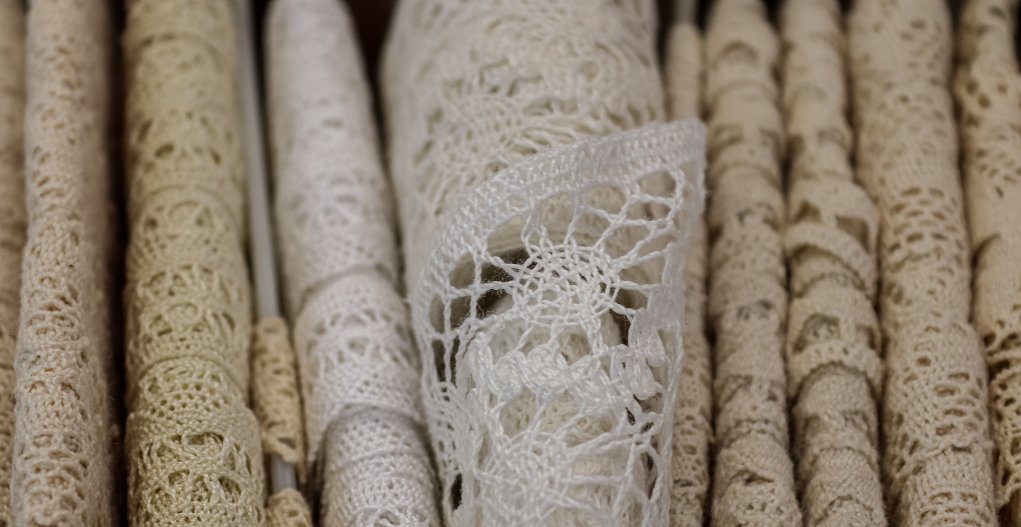Everything you need to know about knitted lace fabric – from history and production to modern trends and expert care tips
Table of Contents
What is Knitted Lace Fabric?
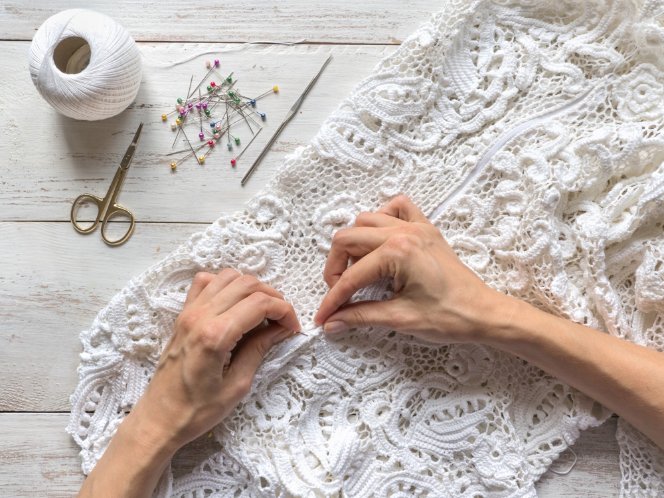
Knitted lace fabric combines the stretch and comfort of knitted textiles with the delicate beauty of traditional lace patterns. Unlike regular lace fabric, which can be rigid and structured, knitted lace offers flexibility that moves with your body while maintaining intricate openwork designs.
Key Difference: While traditional lace is woven or created with bobbins and needles, knitted lace is made using knitting techniques that create loops and stitches. This gives it natural stretch and recovery properties that other lace types lack.
The magic happens through strategic yarn placement and stitch combinations. Knitters use techniques like yarn-overs and decreases to create airy motifs while preserving the fabric’s structural integrity. This balance makes knitted lace perfect for garments that need both flexibility and detailed aesthetics.
Is Lace a Knitted Fabric?
Not all lace is knitted fabric. Chantilly lace, guipure lace, and Alençon lace are created using different methods like bobbin lace-making or embroidery. However, knitted lace specifically refers to lace patterns created through knitting techniques.
The Difference Between Knitted Lace and Lace Knitting
Here’s where it gets interesting. These terms are often confused, but they’re actually different:
- Knitted Lace: Refers to the finished fabric or textile that has lace-like openwork patterns created through knitting
- Lace Knitting: Refers to the technique or process of creating lace patterns using knitting needles and yarn
History and Evolution of Knitted Lace
The story of knitted lace begins in the 16th century, when knitters in Europe started experimenting with creating openwork patterns in their knitted fabrics. Unlike the elaborate needle lace that adorned royal courts, knitted lace offered a more practical approach to decorative textiles.
Early Origins
Spanish and Italian knitters were among the first to master lace knitting techniques. They discovered that by combining yarn-overs (which create holes) with decreases (which maintain stitch count), they could create intricate patterns that rivaled traditional lace-making methods.
Regional Developments
Different regions developed their own signature styles:
- Shetland Lace Knitting: Originating from Scotland’s Shetland Islands, this style is famous for its gossamer-thin shawls and complex geometric patterns
- Estonian Lace: Known for intricate leaf and floral motifs with nupps (bobbles) for added texture
- Orenburg Lace: Russian tradition creating shawls so fine they could pass through a wedding ring
Industrial Revolution Impact
The 19th century brought mechanical knitting machines that could replicate some lace patterns. However, the finest knitted lace still required hand knitting skills that machines couldn’t match. This created a divide between mass-produced machine lace and artisanal hand-knitted pieces.
Types and Comparison of Knitted Lace
| Type | Stretch Level | Durability | Best Use | Price Range |
|---|---|---|---|---|
| Cotton Knitted Lace | Medium | High | Everyday wear, home décor | $39-$69/yard |
| Silk Knitted Lace | Low-Medium | Medium | Luxury garments, bridal | $149-$450/yard |
| Synthetic Knitted Lace | High | High | Activewear, budget projects | $2.99-$25/yard |
| Wool Knitted Lace | High | Medium | Shawls, winter accessories | $45-$120/yard |
Is Knitted Lace Stretchy?
Yes, knitted lace is typically stretchy! This is one of its main advantages over traditional woven lace. The knitted structure allows the fabric to stretch and recover, making it more comfortable for fitted garments. However, the amount of stretch depends on:
- Fiber content (synthetic fibers offer more stretch)
- Knitting technique and stitch pattern
- Yarn weight and tension
Knitted Lace vs. Crochet Lace
While both create openwork fabrics, they differ significantly:
| Aspect | Knitted Lace | Crochet Lace |
|---|---|---|
| Tools | Two or more needles | Single hook |
| Structure | Interlocking loops | Single loops pulled through others |
| Stretch | More stretchy | Less stretchy |
| Speed | Generally slower | Usually faster |
Production Techniques
Traditional Hand Knitting Methods
Creating knitted lace by hand requires mastering several key techniques:
- Yarn-overs: Create the characteristic holes in lace patterns
- Decreases: Maintain stitch count while shaping the fabric
- Charts: Visual representations of complex patterns
- Lifelines: Safety threads to prevent unraveling mistakes
What Needles to Use for Lace Knitting?
The right needle choice makes a huge difference in lace knitting:
- Circular needles: Best for large projects like shawls
- Sharp-pointed needles: Essential for precision work
- Size: Usually 2-4 sizes larger than recommended for the yarn
- Material: Metal or bamboo, depending on personal preference
Modern Machine Production
Today’s knitted lace production combines traditional techniques with modern technology:
- Computer-controlled machines: Create consistent patterns at scale
- Digital pattern libraries: Store thousands of historical designs
- Quality control systems: Laser-guided inspection for defects
How Does Lace Knitting Work?
The basic principle involves creating decorative holes (eyelets) in a knitted fabric while maintaining its structural integrity. Here’s the process:
- Plan the pattern: Chart out where holes and solid areas will be
- Create yarn-overs: Wrap yarn around needle to form holes
- Work decreases: Reduce stitches to balance the yarn-overs
- Block the finished piece: Stretch and pin to reveal the pattern
Materials and Design Elements
Natural vs. Synthetic Fiber Choices
Your fiber choice dramatically affects the final product’s look, feel, and performance. Here’s what you need to know about each option:
Natural Fibers
Silk remains the gold standard for luxury knitted lace. Its natural protein structure provides unmatched sheen and drape, making it perfect for beaded lace designs and formal wear. However, at $149-$450 per yard, it’s a significant investment.
Cotton offers the best balance of beauty and practicality. It accepts dyes beautifully, maintains softness through washing, and works well in both warm and cool climates. Cotton knitted lace is particularly popular for children’s clothing and home décor because it’s safe and comfortable for sensitive skin.
Linen creates rustic, textured knitted lace that’s perfect for casual summer garments. While it requires careful handling during knitting, the finished fabric has excellent durability and improves with age.
Synthetic Options
Modern synthetic fibers have revolutionized knitted lace production. Polyester blends starting at $2.99 per yard make decorative textiles accessible to budget-conscious consumers. These materials resist wrinkles, maintain shape through repeated washing, and often include stretch fibers for enhanced comfort.
Rayon mimics silk’s drape at a fraction of the cost, though it lacks natural breathability. It’s an excellent choice for evening wear where appearance matters more than long-term durability.
What is the Best Yarn for Lace Knitting?
The best yarn depends on your project, but here are some general guidelines:
- Beginners: Cotton or cotton blends for forgiveness and ease of care
- Shawls: Silk or silk blends for drape and luxury feel
- Everyday wear: Superwash wool for warmth and stretch
- Home décor: Linen or cotton for durability and washability
2025 Fashion Trends in Knitted Lace
Market Growth
The global lace fabric market is experiencing unprecedented growth, with knitted lace leading the charge. Market value: $2.5 billion in 2023, projected to reach $4.1 billion by 2032 with a steady 5.5% annual growth rate.
Key Trends Shaping 2025
Minimalist Elegance
2025 fashion embraces subtle sophistication. Instead of elaborate patterns, designers favor clean lines and simple lace details. Think perfectly finished hems with delicate lace trim on structured blazers, or subtle lace panels on everyday dresses.
High-Contrast Drama
Black knitted lace over bright colored fabrics creates striking visual effects that photograph beautifully for social media. This trend works particularly well for evening wear and special occasion pieces.
Vintage Revival
Victorian-inspired patterns are making a comeback, but with modern construction techniques. Expect to see historical motifs recreated in stretchable knitted lace that offers contemporary comfort.
Athleisure Integration
The most surprising trend is knitted lace in activewear. Moisture-wicking synthetic laces with four-way stretch are appearing in yoga tops, sports bras, and athletic leggings. This merger of beauty and function represents the future of performance textiles.
Sustainable Innovation
Environmental consciousness is driving innovation in knitted lace production. Brands are investing in:
- Organic cotton and linen sourcing
- Recycled polyester from ocean plastic
- Waterless dyeing processes
- Closed-loop manufacturing systems
Modern Applications of Knitted Lace
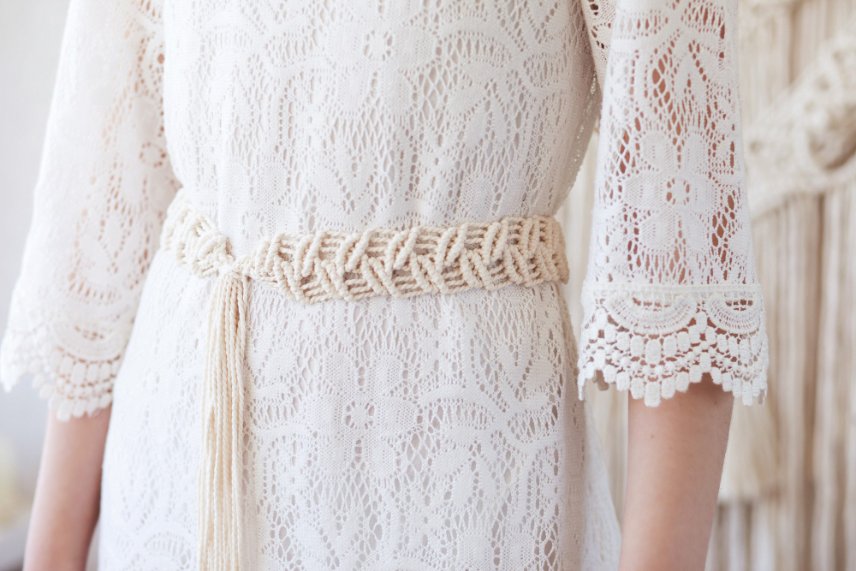
Fashion Applications
Bridal and Special Occasion Wear
Knitted lace has revolutionized bridal fashion by offering comfort without sacrificing elegance. Modern brides can dance, sit, and celebrate for 12+ hours in gowns that move with them. The stretch properties eliminate the need for complicated corseting while maintaining a flattering silhouette.
Intimate Apparel
The lingerie industry has embraced knitted lace for its comfort and stretch. Embroidered lace details on bras and panties now move naturally with the body, eliminating uncomfortable pinching or binding.
Ready-to-Wear Fashion
Contemporary fashion designers use knitted lace as both primary fabric and accent material. From subtle collar trims to full lace tops, the versatility allows for creative expression across all price points.
Home Décor Applications
| Application | Key Features | Popular Uses |
|---|---|---|
| Window Treatments | Light diffusion, privacy control | Sheer drapes, valances |
| Table Accents | Stain resistance, drape quality | Runners, placemats |
| Lighting Elements | Heat resistance, pattern projection | Lampshades, pendant covers |
Interior designers appreciate knitted lace’s ability to add texture without visual weight. A lampshade with knitted lace panels casts beautiful patterned shadows, while table runners with lace borders elevate casual dinner settings.
Care and Maintenance Guide
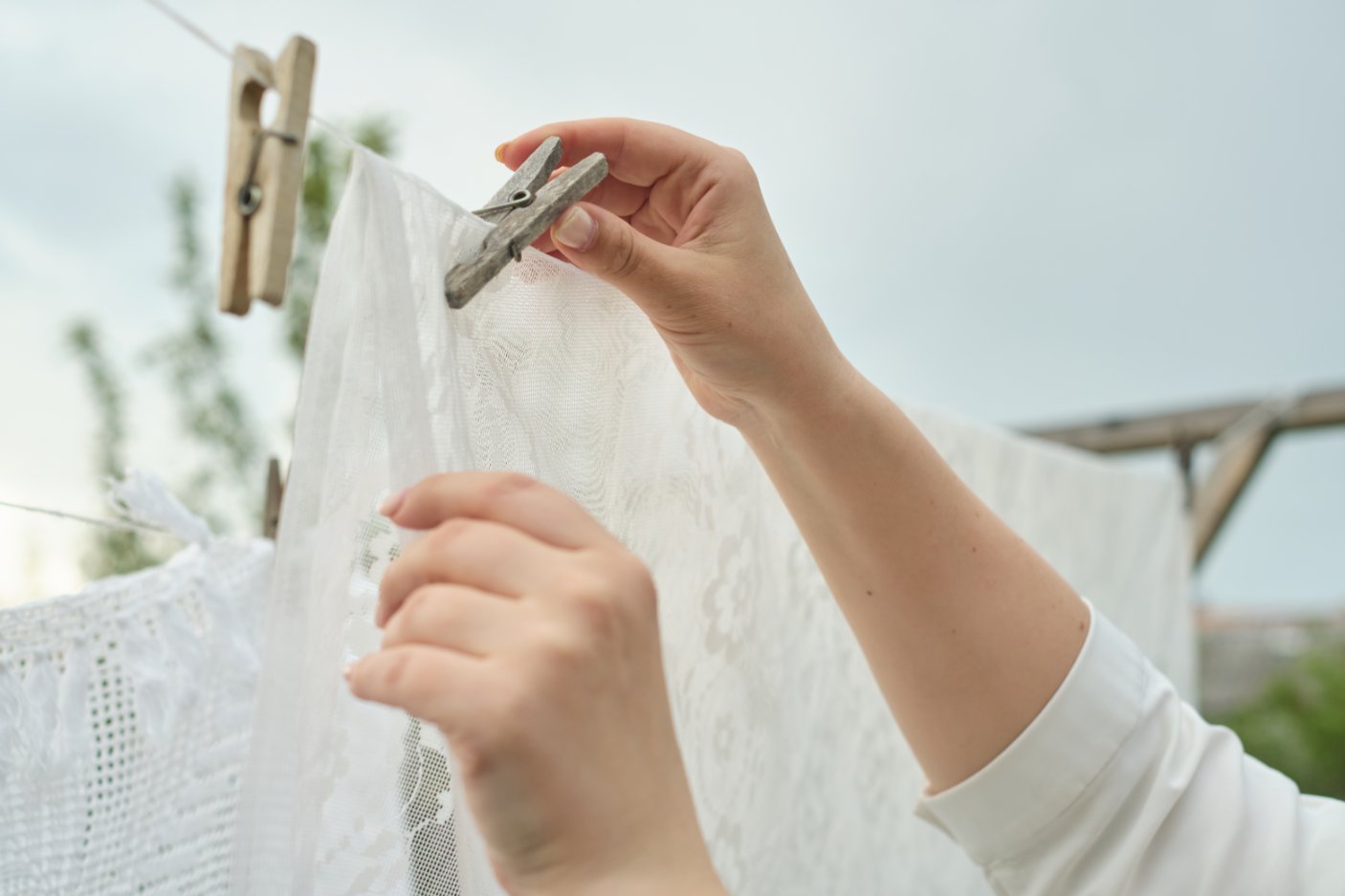
Essential Care Instructions
Proper care extends the life of your knitted lace garments and maintains their beauty. The delicate structure requires gentle handling, but with the right techniques, you can keep pieces looking new for years.
Hand Washing (Recommended Method)
- Prepare the wash: Fill a clean basin with cool water and add a small amount of gentle detergent or baby shampoo
- Test first: Check colorfastness on a hidden area
- Soak gently: Submerge the lace and let it soak for 30 minutes
- Agitate minimally: Gently swish the fabric without rubbing or wringing
- Rinse thoroughly: Use cool, clean water until all detergent is removed
Machine Washing (When Permitted)
If your care label allows machine washing:
- Use a mesh laundry bag for protection
- Select delicate cycle with cold water
- Use gentle detergent without bleach or fabric softener
- Wash similar colors together
Drying Techniques
Never use a dryer for knitted lace. The heat can damage fibers and cause shrinkage. Instead:
- Lay flat on clean, absorbent towels
- Gently press out excess water (don’t wring)
- Reshape while damp
- Air dry away from direct sunlight
- Use blocking techniques for optimal results
Storage Best Practices
- Store flat or loosely rolled with acid-free tissue paper
- Keep in breathable fabric bags, not plastic
- Avoid hanging delicate pieces
- Store away from direct sunlight
How to Block Lace Knitting
Blocking is crucial for revealing the full beauty of knitted lace patterns. This process involves wetting the finished piece and stretching it to the correct dimensions:
- Wet the lace: Soak in cool water for 30 minutes
- Remove excess water: Roll in towels and press gently
- Pin to measurements: Use rust-proof pins on blocking mats
- Allow to dry completely: Don’t remove pins until fully dry
Stain Removal
For stubborn stains, try cornstarch before washing. Sprinkle it on the stained area, let sit for 30 minutes, then proceed with normal washing. This technique works well on both fresh and set-in stains without damaging delicate fibers.
Quality Testing and Durability Standards
Understanding quality standards helps you make informed purchasing decisions and ensures your knitted lace performs as expected. Professional testing evaluates several key characteristics:
Physical Testing Methods
Bursting Strength
This test measures how much pressure knitted lace can withstand before fibers break. It’s particularly important for fitted garments where stress concentrates at seams and curves. Quality knitted lace should maintain structural integrity even when stretched.
Dimensional Stability
Good knitted lace maintains its shape through washing and wearing. Testing involves measuring shrinkage and expansion under various conditions. Look for fabrics that return to their original dimensions after stretching.
Abrasion Resistance
This determines how well the fabric withstands rubbing against other surfaces. For knitted lace used in garments, higher abrasion resistance means longer-lasting beauty.
Quality Indicators to Look For
Premium Quality
Excellent
- Consistent stitch formation
- Even tension throughout
- No loose threads or holes
- Proper pattern registration
Standard Quality
Good
- Generally consistent stitches
- Minor tension variations
- Occasional loose threads
- Acceptable pattern alignment
Budget Quality
Fair
- Irregular stitch sizes
- Noticeable tension issues
- Multiple loose threads
- Pattern misalignment
Red Flags to Avoid
- Excessive pilling: Indicates poor fiber quality
- Color bleeding: Shows inadequate dye fixation
- Uneven shrinkage: Results in warped patterns
- Harsh feel: Suggests over-processing or poor finishing
Complete Buying Guide
Price Range Breakdown
Understanding pricing helps you budget appropriately and set realistic expectations for quality:
Budget Range
$2.99 – $15/yard
Synthetic blends, machine-made, suitable for practice projects and temporary use
Mid-Range
$25 – $80/yard
Cotton or cotton blends, good quality construction, perfect for everyday garments
Premium Range
$100 – $450/yard
Silk, wool, or luxury blends, often hand-finished, ideal for special occasions
Where to Source Quality Knitted Lace
Online Retailers
Online shopping offers the widest selection and competitive pricing. Look for retailers that provide detailed product descriptions, care instructions, and return policies. Always order samples when possible to assess quality before committing to larger purchases.
Specialty Fabric Stores
Local fabric stores allow you to feel the texture and assess quality in person. Staff expertise can be invaluable for matching fabric to your specific project needs. Many stores also offer cutting services and can recommend appropriate machine stitches for your fabric choice.
Wholesale Suppliers
For large projects or commercial use, wholesale suppliers offer better pricing. Minimum orders typically start at 20-50 yards, but the cost savings can be substantial for bulk purchases.
Sample Ordering Best Practices
Before committing to large purchases:
- Order 6-8 inch samples to test care procedures
- Test how the fabric behaves with your intended construction methods
- Verify color accuracy under different lighting conditions
- Check for compatibility with your sewing machine settings
DIY and Crafting with Knitted Lace
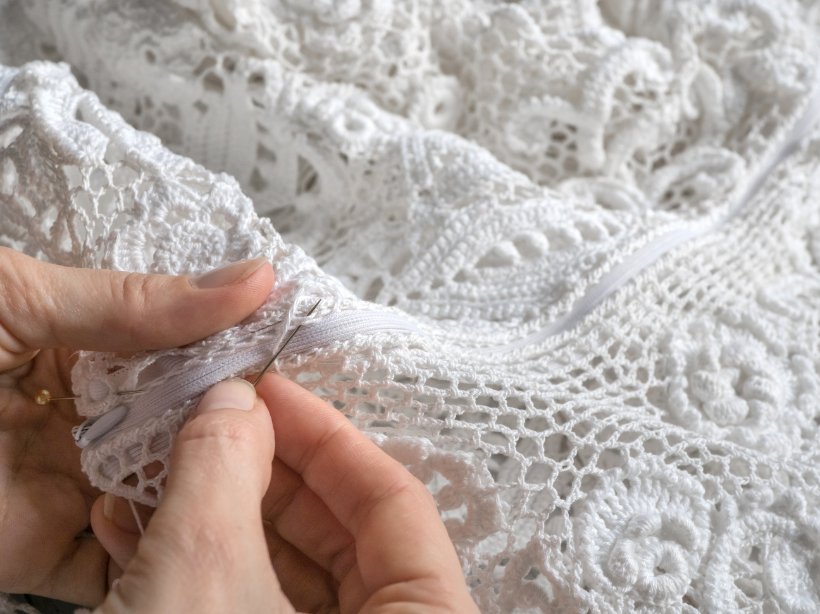
Getting Started with Lace Knitting
Is Knitting Lace Difficult?
Lace knitting has a reputation for being challenging, but it’s more about patience than skill. The techniques themselves are simple – most patterns use only basic knit, purl, yarn-over, and decrease stitches. The complexity comes from combining these elements into intricate patterns.
Essential Tools for Beginners
- Sharp-pointed needles: Essential for working through multiple stitches
- Stitch markers: Help track pattern repeats
- Lifelines: Thin thread or dental floss for mistake insurance
- Pattern charts: Visual guides easier to follow than written instructions
Basic Techniques for Beginners
Learn machine knitting techniques for creating lace patterns – perfect for beginners wanting to understand the basics
Understanding “No Stitch” in Lace Knitting
In lace charts, “no stitch” represents areas where stitches have been decreased away. These empty squares help maintain chart alignment and don’t require any action from the knitter.
How to Join Yarn in Lace Knitting
Never join new yarn in the middle of a lace pattern. Instead:
- Plan joins at pattern edges or simple stockinette sections
- Use the spit-splice method for wool yarns
- Leave long tails for weaving in later
- Test joins on swatches first
How to Cast Off Lace Knitting
Standard bind-offs can distort lace patterns. Use these techniques instead:
- Stretchy bind-off: Maintains elasticity for shawl edges
- Picot bind-off: Creates decorative scalloped edges
- Russian bind-off: Provides firm but flexible edges
Reading Lace Knitting Patterns
Lace patterns use both written instructions and charts. Charts show exactly what the finished fabric looks like, making them easier to follow once you understand the symbols. Start with simple patterns and gradually work up to more complex designs.
Common Beginner Projects
- Dishcloths: Practice basic techniques on useful items
- Scarves: Simple rectangular shapes with decorative edges
- Baby blankets: Larger projects to build confidence
- Shawlettes: Small shawls perfect for learning new stitches
Does Lace Knitting Use More Yarn?
Surprisingly, lace knitting often uses less yarn than solid knitting because of all the holes in the pattern. However, lace projects tend to be larger (like full-size shawls), which can offset the yarn savings.
Environmental Impact and Sustainability
Eco-Friendly Fiber Practices
The environmental impact of knitted lace varies dramatically depending on fiber choice and production methods. Understanding these factors helps you make responsible purchasing decisions.
Natural Fiber Environmental Impact
Organic Cotton represents the most sustainable choice for natural fibers. It reduces harmful agrochemical use by 91% compared to conventional cotton farming. However, cotton production remains water-intensive, requiring approximately 2,700 liters of water per t-shirt equivalent.
Linen production offers excellent sustainability credentials. Flax plants require minimal irrigation and use the entire plant, creating zero waste. However, only 5% of global flax crops currently use organic methods.
Silk production provides renewable processes using natural mulberry leaves, but its water-intensive nature challenges sustainability claims. The industry is investing in closed-loop water systems to address this concern.
Synthetic Fiber Considerations
Synthetic knitted lace contributes to microplastic pollution, with 35% of ocean microfibers tracing back to petroleum-based textiles. However, innovations in recycled polyester from ocean plastic offer promising alternatives.
Certification Programs
Look for these certifications when choosing sustainable knitted lace:
- USDA Organic: Validates natural fiber sourcing without harmful chemicals
- Global Recycled Standard: Tracks recycled content and supply chain practices
- OEKO-TEX Standard 100: Guarantees non-toxic processing and finishing
- Cradle to Cradle: Evaluates entire product lifecycle impact
Sustainable Care Practices
Extend fabric life and reduce environmental impact through proper care:
- Wash in cold water to save energy and preserve fibers
- Air dry instead of using machine heat
- Use eco-friendly detergents without phosphates
- Repair rather than replace when possible
End-of-Life Considerations
Natural fiber knitted lace can be composted at end-of-life, returning nutrients to soil. Synthetic versions require textile recycling programs, which are becoming more widely available in major cities.
Frequently Asked Questions
The two main categories are weft knitting (like jersey and rib knits) and warp knitting (like tricot and raschel). Knitted lace can be created using either method, though weft knitting is more common for hand-knitted pieces.
Lace knitting typically uses stockinette stitch as a base with yarn-overs and decreases to create openwork patterns. The knit structure provides stretch and recovery while maintaining decorative appeal.
Yes, knitted fabrics are naturally stretchable due to their loop structure. This includes knitted lace, which offers more stretch than woven lace alternatives. The amount of stretch depends on fiber content and knitting technique.
Knotted lace is a different technique entirely, using knots rather than knitted loops. Examples include macramé and tatting. It’s more structured and less stretchy than knitted lace.
Raschel lace is a warp-knitted fabric that creates lace-like patterns using multiple yarns and guide bars. It’s commonly used in commercial lace production.
Start with simple eyelet patterns using yarn-overs and basic decreases. Practice on swatches before attempting full projects. Use pattern reading skills to understand charts and written instructions.
Use stretchy bind-off methods to maintain the fabric’s natural drape. Standard bind-offs can distort lace patterns and create tight edges that don’t match the fabric’s stretch.
Complex colorwork combined with intricate lace patterns represents the ultimate knitting challenge. Fair Isle lace shawls and multi-color cables require advanced planning and execution skills.
Knitting creates more elastic, drapeable fabrics ideal for fitted garments. The two-needle technique also allows for more complex stitch patterns and smoother fabric surfaces.
Use ballpoint needles, stretch stitches, and proper seam allowances. Stabilize seams with stay tape when needed, and avoid pulling the fabric while sewing.
Knitted stitches interlock in multiple directions, creating flexibility in all dimensions. Crochet stitches link in single chains, providing less overall stretch and recovery.
Knitted fabrics generally wrinkle less than woven fabrics due to their elastic structure. However, natural fibers like cotton and linen knits can still wrinkle, while synthetic blends resist wrinkling better.
Incorporate knitted lace as trim on various fabric types, use it for overlay effects, or combine with solid knits for textural contrast. Consider stretch compatibility when mixing fabrics.
Irish lace knitting combines motifs with mesh grounds. Create individual flowers, leaves, or geometric shapes, then connect them with fine mesh patterns. This technique requires advanced skills and patience.
Lace knitting originated in 16th century Europe, with Spanish and Italian knitters developing the earliest techniques. Regional styles evolved in Shetland, Estonia, and Russia, each with distinctive patterns and methods.
Conclusion
Knitted lace fabric represents a perfect marriage of traditional craftsmanship and modern innovation. From its humble beginnings in 16th century Europe to today’s high-tech production methods, this versatile textile continues to evolve while maintaining its essential charm and elegance.
The key to success with knitted lace lies in understanding its unique properties. Unlike rigid traditional lace, knitted versions offer stretch and recovery that make them ideal for contemporary garments and applications. Whether you’re choosing cotton for everyday comfort or silk for luxury occasions, the right fiber selection dramatically impacts your project’s success.
Key Takeaways
- Versatility is paramount: Knitted lace works in everything from structured garments to flowing home décor pieces
- Care determines longevity: Proper washing, drying, and storage techniques can extend fabric life by decades
- Quality varies significantly: Understanding testing standards and quality indicators helps you make informed purchasing decisions
- Sustainability matters: Choose certified organic or recycled options when possible to minimize environmental impact
- Trends are cyclical: Classic techniques remain relevant while new applications continue emerging
Looking Forward
The future of knitted lace looks bright, with innovations in sustainable production, smart textiles, and digital design tools opening new possibilities. The growing market, projected to reach $4.1 billion by 2032, reflects consumer appreciation for textiles that combine beauty with functionality.
Whether you’re a fashion designer seeking the perfect fabric for your next collection, a home decorator looking to add elegant touches, or a craft enthusiast ready to try lace knitting, understanding these fundamentals will guide your decisions. Remember that the best knitted lace isn’t necessarily the most expensive – it’s the one that perfectly matches your project’s requirements for appearance, durability, and care.
As you explore the world of knitted lace, take time to appreciate both its technical complexity and artistic beauty. Each piece represents countless hours of skilled work, whether created by hand or produced with modern machinery. By choosing quality fabrics and caring for them properly, you’re preserving a textile tradition that spans centuries while enjoying its benefits in contemporary life.
The journey from understanding basic knitted lace concepts to mastering advanced cutting techniques and construction methods takes time, but the results justify the effort. Start with simple projects, invest in quality materials, and don’t hesitate to seek expert advice when needed. Your future self will thank you for taking the time to learn these valuable skills and knowledge.
References:
- American Association of Textile Chemists and Colorists (AATCC) – Industry testing standards and methods
- ISO Technical Committee 38 – Textiles – International textile quality standards
- OEKO-TEX Association – Textile sustainability and safety certifications

